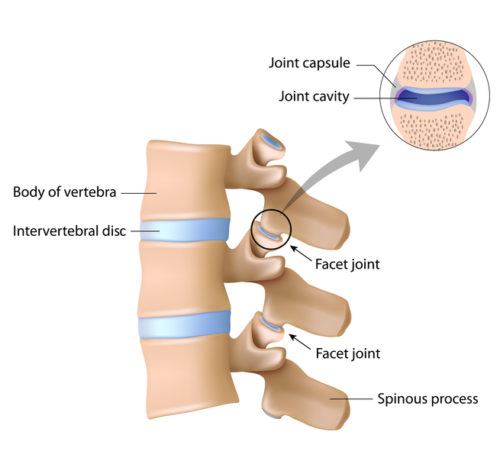Radiofrequency Facet Joint Denervation
 Radiofrequency facet joint denervation is a safe and effective day case procedure for the treatment of back or neck pain arising from the lumbar, thoracic or cervical facet joints. It is also known as radiofrequency ablation, neurotomy, lesioning or rhizolysis.
Radiofrequency facet joint denervation is a safe and effective day case procedure for the treatment of back or neck pain arising from the lumbar, thoracic or cervical facet joints. It is also known as radiofrequency ablation, neurotomy, lesioning or rhizolysis.
Facet joints connect the bones of the spine. These small joints at the back of the spine provide stability and flexibility to the spine and can become painful with age, wear and tear or with injury. The facet joints are the source of pain in up to 40% of older patients with back pain and over 50% of patients with neck pain after whiplash injuries. Medial branch nerves, located near the facet joints, transmit the pain signals from the facet joints to your brain.
If the lumbar or cervical facet joints have been confirmed as the source of your pain, usually by diagnostic medial branch blocks (see cervical and lumbar medial branch blocks), then it is likely that radiofrequency facet joint denervation will be an effective treatment for your back or neck pain. Radiofrequency energy is used to disrupt the function of a medial branch nerve, so that it can no longer transmit pain signals from a facet joint.
Radiofrequency facet joint denervation is performed as a day procedure at North Shore Private Hospital in a specialised x-ray facility. All patients are given intravenous sedation to ensure they are as comfortable as possible throughout the procedure. The doctor performing the procedure will use local anaesthetic to numb your skin before accurately inserting a needle using x-ray guidance next to the medial branch nerve to the facet joint. The doctor will then check that the needle is properly positioned by stimulating the nerve. This may cause muscle twitching and provoke some of your pain. Once the needle is in the correct position, the area will be numbed and radiofrequency energy used to disrupt the medial branch nerve. Several nerves may need to be treated to obtain optimal pain relief. You will be monitored for 1-2 hours following the procedure prior to discharge.
Radiofrequency facet joint denervation is a minimally invasive procedure and serious side effects are rare. You may experience local bruising and discomfort and may feel sore for up to one or two weeks. This is normal, and is usually due to muscle and nerve irritation. Full pain relief from the procedure may take several weeks. Most patients are able to return to work within two days following the procedure.
Nerves regenerate after radiofrequency facet joint denervation. This usually takes between six months and two years. Your pain may or may not return when the nerve regenerates. If it does, the procedure can be repeated on multiple occasions as required.
Any surgical or invasive procedure carries risks. Before proceeding, you should seek a second opinion from an appropriately qualified health practitioner. Northern Pain Centre can facilitate you obtaining a second opinion. Please discuss this with us.
Video courtesy of Nimbus
Learn more
- Northern Pain Centre Patient Education Sheet – Radiofrequency Denervation
- Northern Pain Centre Patient Education Sheet – Preoperative Medication List – Category B
Image courtesy of MSK Australia
Disclaimer
The contents contained within this page are not a substitute for your own independent health professional’s advice, diagnosis or treatment. Northern Pain Centre treats every patient’s condition individually and provides evidence-based treatments to suit this. Treatment’s may vary based on this individual assessment and your medical history. If you would like to find out whether our treatments are suitable for your specific condition, please arrange a consultation with one of our team. Please note there are risks associated with any procedure, and some are more common than others. You should discuss the risks associated with any recommended treatment with your doctor. Before proceeding, you should seek a second opinion from an appropriately qualified health practitioner. Northern Pain Centre can facilitate you obtaining a second opinion. Please discuss this with us.